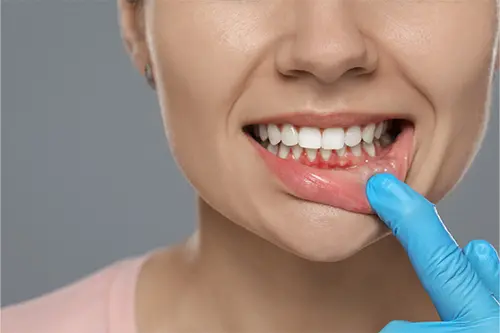Reviewed by Dr. Kerri Font, DDS
Reading time: three minutes

Have you noticed bleeding when you brush or that your gums look a little swollen? These early signs of gum problems are easy to dismiss, but they may point to more than just irritation.
Gum disease starts with gingivitis and, if untreated, can progress to periodontal disease, a much more serious condition. While both affect your gums, they differ in severity, symptoms, and treatment.
Table of Contents
- What Is Gingivitis?
- What Is Periodontal Disease?
- Causes and Risk Factors
- How Are Gingivitis and Periodontal Disease Treated?
- Partner With Highlands Ranch for Better Gum Health
- FAQs
What Is Gingivitis?
Gingivitis is the earliest stage of gum disease and the only stage that can be reversed. It happens when plaque and bacteria build up along the gumline, irritating the tissue.
Common Symptoms of Gingivitis
Before we list the signs, it’s helpful to know that gingivitis often develops silently. Many people don’t feel pain at this stage, which makes it easy to ignore until symptoms become noticeable.
Look out for:
- Red, swollen, or tender gums
- Bleeding when brushing or flossing
- Persistent bad breath (halitosis)
- Gum sensitivity
With early detection and proper dental care, gingivitis can usually be treated with professional cleanings and improved home care.
| Why Early Treatment MattersIf gingivitis isn’t treated, it can progress to periodontal disease, which increases the risk of tooth loss and may impact overall health. Research shows links between periodontal disease and conditions like heart disease, diabetes, and respiratory illness. Treating gum problems early protects not only your smile but also your whole-body wellness. |
What Is Periodontal Disease?
If gingivitis is left untreated, it can progress into periodontal disease, also known as periodontitis or gum disease. This is a serious infection that damages the gums, supporting tissues, and bone around the teeth. Unlike gingivitis, periodontitis cannot be reversed but it can be managed with professional periodontal treatment.
Common Symptoms of Periodontal Disease
Once gum disease advances, symptoms are more obvious and often painful. These include:
- Receding gums that make teeth look longer
- Loose or shifting teeth
- Deep pockets forming between gums and teeth
- Pus between teeth and gums
- Pain when chewing
- Tooth loss in severe cases
Causes and Risk Factors
Both gingivitis and periodontal disease share similar root causes, but the severity depends on progression and risk factors.
- Plaque buildup: The main cause of gum disease.
- Poor oral hygiene: Infrequent brushing and flossing allow bacteria to thrive.
- Smoking and tobacco use: One of the strongest risk factors.
- Hormonal changes: Pregnancy, menopause, or puberty can increase gum sensitivity.
- Medical conditions: Diabetes, heart disease, and immune disorders raise risk.
- Genetics: Some people are more prone to gum disease regardless of hygiene.
How Are Gingivitis and Periodontal Disease Treated?
Treatment depends on the stage of gum disease. Gingivitis can often be reversed with professional cleaning and consistent home care, while periodontal disease requires specialized periodontal care.
Gingivitis Treatment
- Professional dental cleaning every 6 months
- Brushing and flossing twice a day
- Antibacterial mouth rinses
- Regular dental checkups
Periodontal Disease Treatment
Once the disease progresses, more advanced procedures are needed to stop further damage. These may include:
- Scaling and root planing (deep cleaning below the gumline)
- Periodontal surgery to reduce pocket depth and restore gum health
- Bone or gum grafts in severe cases
- Long-term maintenance cleanings with a periodontist every 3 months
Partner With Highlands Ranch for Better Gum Health
Gingivitis and periodontal disease may sound similar, but their impact is very different. Gingivitis is mild and reversible, while periodontitis is severe and requires ongoing care. The good news? With regular checkups, early intervention, and proper oral hygiene, you can protect your gums and maintain a healthy smile for life.
Contact Highlands Ranch Periodontics & Dental Implants to schedule a periodontal evaluation at one of our two Colorado locations:
- Highlands Ranch office: 9090 S Ridgeline Blvd. #225, Highlands Ranch, CO 80129. Call (303) 683-1144 to schedule your visit.
- Sloan’s Lake office: 1525 North Raleigh Street Suite 130, Denver, CO 80204. Call (303) 683-1144 for an appointment.
FAQs
Gingivitis is early-stage gum inflammation that can be reversed, while periodontal disease is advanced gum infection that causes permanent damage if untreated.
Brush twice daily, floss, avoid smoking, eat a balanced diet, and schedule regular dental cleanings.
If your gums are red, swollen, and bleed when brushing but your teeth still feel firm, it’s likely gingivitis. If you notice gum recession, loose teeth, or pain when chewing, it may be periodontal disease. Only a dental professional can confirm the diagnosis.
There’s no exact timeline, but untreated gingivitis can progress to periodontitis in several months to a few years, depending on oral hygiene, smoking habits, and other health factors.
An non-alcohol antibacterial mouthwash that targets plaque and bacteria can help reduce gingivitis. Look for one with ingredients like chlorhexidine, cetylpyridinium chloride, or essential oils. Your dentist or periodontist can recommend the most effective option for your needs.
Highlands Ranch Periodontics & Dental Implants offers comprehensive gum disease treatment at two Colorado locations: Highlands Ranch and Sloan’s Lake. Call (303) 683-1144 to schedule an appointment with one of our experienced periodontists.
